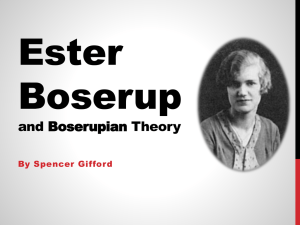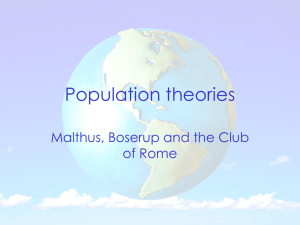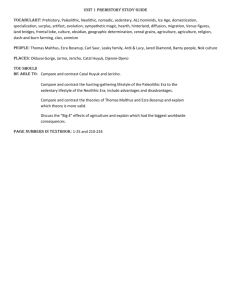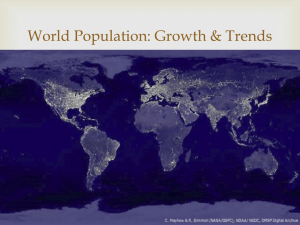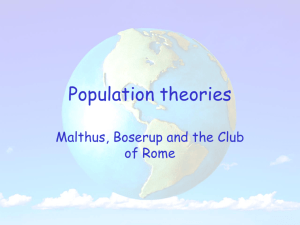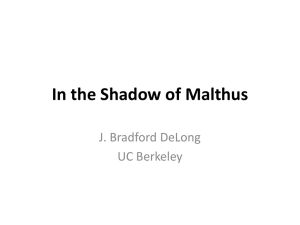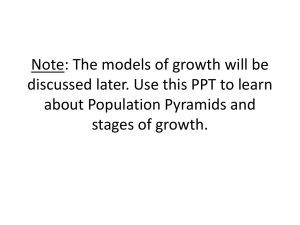File
advertisement
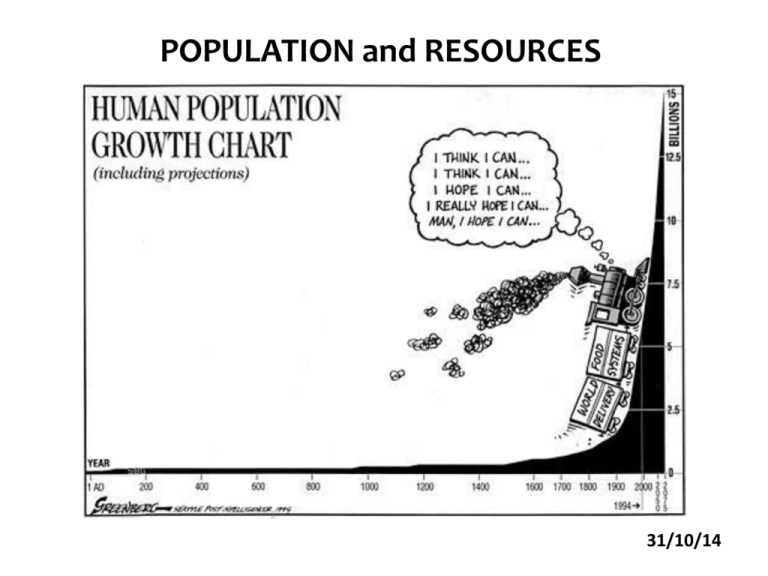
POPULATION and RESOURCES 31/10/14 LEARNING OBJECTIVES 1) Examine the concepts of optimum population, overpopulation, under population and carrying capacity 2) Examine the factors that influence changes in carrying capacity 3) Explore the theories on the relationship between population and resources THE CONTEXT • All development is for the people • People are the ultimate and the only beneficiaries. • Development is directed towards meeting the needs the people. • Development also contributes to capacity building of individuals as well as group of individuals –family, society, etc. • Development needs of the people are not the same. • They vary by basic characteristics of population – Size, Age, Sex • The population stock determines the development needs. • Development modifies the population stock through changes in mortality, fertility and other determinants. 3 POPULATION AND RESOURCES This PPT has been adapted from: http://www.slideshare.net/ecumene/population-9-intro-to-population-and-resources-presentation CONTRASTING PLACES Bangladesh population density = 981 people/km2 Sudan population density = 15.6 people/km2 Which one is over populated? CONTRASTING PLACES Amsterdam (the Netherlands, population density = 397 people/km2) Calcutta (India, population density = 330 people/km2) Which one is over populated? RESOURCES - KEY CONCEPTS 1. Natural resources: environmental: mineral and fossil resources. (i.e.: iron, oil) 2. Human resources: cultural, economic, technological resources 3. Non-renewable resources: finite natural resources (oil, coal, gas), capital (machinery, equipment) 4. Renewable resources: non-finite natural resources: hydro power, wind, solar. 5. Reserves: Many countries hold “emergency” reserves of finite resources (oil, grain, gas) DEFINITIONS 1. Over-population – when there are too many people and not enough resources to provide a high standard of living at a given level of technology. 2. Under-population – when there are not enough people to fully exploit the available resources. 3. Optimum population – is the theoretical number of people which, when working with all the available resources, will produce the highest standard of living and quality of life 4. Carrying capacity – the number of people that can be supported by the available resources within a particular area without the long-term depletion of those resources. Population and Resources Theories on the relationship between population and resources Under-Population Over-Population Optimum Population Benefits Population Impact Problems Population Growth over Time THOMAS MALTHUS • 1766-1834. Born in UK. • Wrote ‘An essay on the Principle of population’. Published in 1798 • World pop. in 1798: 9 million people. • Now: more than 6 billion Malthus recognised that population - if unchecked - grows at a geometric rate: 1 2 4 8 16 32 However, food only increases at an arithmetic rate, as land is finite. 1 2 3 4 5 6 Thomas Malthus : Essay on the Principles of Population 1798 Malthus was the first to notice the impending issue of there being more people than could be supported by the food supply. He noticed farming improvements could raise food production by a certain amount each year – in an arithmetic rate of increase..1, 2, 3, 4, 5, 6…… Whereas population tends to increase at a ‘geometric rate’ with each generation…1, 2, 4, 8, 16, 32……. So he concluded there must come a point when there are too many people for the available food supply Therefore…. Malthusian Catastrophe food population TIME War, famine, disease. Malthus believed that when the population level rose above the food supply – then nature would cause it to decline due to: PESTILENCE PLAGUE FAMINE WAR Malthus suggested that population growth should be limited by people marrying later – and abstaining from sex before and outside of marriage. (he basically wanted to cut the birth rate of the poorer classes) These were very radical things for a vicar to say!! The Core Principles of Malthus: • Food is necessary for human existence • Human population grows faster than the power of the earth to produce food. • The effects of these two unequal powers must be kept equal. • Since humans tend not to limit their population size voluntarily - “preventive checks” are needed. (in Malthus’ terminology) To check = to stop or slow the progress of some unwelcome process. to halt, to stop, to slow something down. NEGATIVE CHECKS (DECREASED BIRTH RATE)…. • Negative Checks: limit pop. growth by decreasing birth rate: Examples: abstinence / delay of marriage. • (Malthus favoured moral restraint as a check on population growth. • However, it is worth noting that Malthus proposed this only for the working and poor classes!) POSITIVE CHECKS (INCREASED DEATH RATE) • Positive Checks: events which increase the death rate such as famine, disease, war increasing the mortality rate and reducing life expectancy. If a population rises above the ‘carrying capacity’ of an environment – it will struggle to survive. There is much debate about what the carrying capacity of Planet Earth is. The ‘carrying capacity’ is the potential of an area to support life long-term. The area must be able to provide: • Food and water • Space for living and shelter • Essential resources for life • Able to absorb waste and pollution Any change in the population or resources in an environment will change the carrying capacity. These changes may be short term or long term. If a population rises above the carrying capacity of its environment, it can cause the environment to deteriorate so that it even less able to sustain a population. Factors influencing carrying capacity include: 1) Population Size 2) Environmental Resistance 3) Resource Innovation Desertification on the margins of the Sahara due to deforestation, over-cultivation of the soil and over-grazing of grasslands means that fewer people can be fed now in many regions than 30 years ago – the carrying capacity has been reduced. Was Malthus right? • ... There has been a population explosion • ... Demand for food is rising rapidly • ... Africa – repeated famines, wars, food crisis, environmental degradation, soil erosion, crop failure and disastrous floods – so was he right? But….. • Technological improvements which he could not have foreseen • More farmland due to irrigation & better technology • Reduced population growth as countries move through the DTM The Demographic transition model (DTM) is a model used to represent the transition from high birth and death rates to low birth and death rates as a country develops from a pre-industrial to an industrialized economic system. The theory was developed in 1929 by the American demographer Warren Thompson. 'J' Curve - Population Crash Model This follows the ideas of Malthus: population rapidly expands, reaching the carrying capacity of the land. As the population exceeds this, famine and disease play havoc with the population and it crashes. Where do famine etc. fit? ‘S' Curve - Stabilisation Model This follows ideas of the demographic transition model over time. A low base population is followed by a rapidly expanding one that finally stabilizes at a new high population level. Neo-Malthusians would say that the frequent famines in Ethiopia and Sudan are evidence of Malthus’ basic theories being right ….too many people out-weighing the available food resources ….but how come Britain never had the ‘famine’ that Malthus predicted – and we now suffer from too much food with an obesity epidemic? Whilst Malthus’ prediction for Britain were not to come about in his lifetime, by the 1970s demographers felt there was no putting off his predictions any longer. The Club of Rome was a gathering of scientists who said in 1972 that unless the population of the earth was restricted by population control policies, then humanity faced a disastrous future with food shortages a certainty within 100 years. These theorists are known as NeoMalthusians (‘new Malthusians’ – using his ideas) Their book ‘Limits to Growth’ is the best selling book on the environment – ever. Ester Boserup 1965 • Boserup believed that people have resources of knowledge and technology and that “necessity is the mother of invention”, thus as populations grow towards the carrying capacity, people develop new ways to use resources (food) more productively. • Can you think of real life examples? Esther Boserup (1965) : The belief in human ingenuity to come up with solutions at times of crisis. This theorist claimed that rising populations are not a problem. In fact, Boserup suggested that it was at times when there were food shortages following periods of population growth, that people were forced to come up with better ways of producing food in order to survive. Summed up best by the phrase : Necessity is the mother of invention. Thus……. • Demographic pressure (population density) promotes innovation and higher productivity in use of land (irrigation, weeding, crop intensification, better seeds) and labour (tools, better techniques). Whose view on population growth is this? Ester Boserup Whose view on population growth is this? Malthus But…. • Boserup admits overpopulation can lead to unsuitable farming practices which may degrade the land • population pressure as one of the reasons for desertification in the Sahal region (so fragile environments at risk) • Potential consequences of Green Revolution Was Boserup Right? What about resource degradation and pollution? Can we continue to innovate to overcome these issues? When Mao-Zedong, the Chinese leader was asked in the 1960s how the country could cope with the increasing number of mouths to feed, he replied…. “With every stomach….comes a pair of hands ! “ His priorities for China were: Defence – building a big army Industrialisation – to modernise China He saw ‘more people’ as the best way to achieve both these. Population Policies : Managing Population and Resources Carrying Capacity : The ability of an area to ‘support’ its population by providing the essentials of life – food, water, living space, waste disposal. As countries develop they move away from being SelfSufficient in food (and possibly water) and resources – and develop Wealth-Creating Industry (factories, banking or tourism) to be able to import the food and resources they need. This is why the UK didn’t have the famines that Malthus predicted in the 1790s. See BBC report on Optimum Population Trust Overpopulation : When the people in the country would be better off if there were fewer of them. There may be insufficient food, water, resources or living space. Policies may aim to encourage people to emigrate, prevent immigration, and encourage people to have fewer children. E.g China Underpopulation : When the people in the country would be better off if there were more of them. More people to exploit the country’s resources, be consumers for industry, pay taxes and give political/military strength e.g Australia, Canada, Brazil. Optimum Population : Where the population size is ‘just right’ for the resources available to the country. It’s very difficult to know what a country’s ‘optimum is. Some people argue that the UK would be better if it only had 35m people (on environmental grounds) whereas other suggest we could compete better with Germany and Japan if we had 80m (on economic grounds) Population Policies : Historical Evidence of when Population gets out of balance with Resources Easter Island : • Isolated island in the Pacific • Evidence of a thriving culture in the 1600s-1700s • Population grew, cultivated more land and thrived. • By 1800 the population had declined considerably and was in a state of poor diet, poor health and much deprivation. • It is believed that as the population grew, more land was cleared of forest for farmland. • As all the land was used up, the soil was over-used and then exhausted. • Deforestation caused soil erosion and reduced the food production • As resources declined, tribal groups went to war with each other for scarce resources • The loss of trees meant no more boats could be built to allow people to escape the islands. • By the 1800s the population was declining through warfare, inadequate food, and deteriorating soil conditions. Malthus’s theory exactly. Population Policies : Modern Evidence of when Population gets out of balance with Resources Mauritius : • Isolated island in the Indian ocean • Population was growing rapidly in the 1950s leading to overcultivation • The island was rapidly approaching over-population • The government and religious faiths came together to.,,, a) Reduce the population growth rate by introducing contraceptives. The fertility rate fell from 4.2 to 2.8 in a decade as women embraced the opportunity to limit the number of children they gave birth to b) Increase the food production of the island by (i) de-rocking the fields to increase the land that could be cultivated (ii) dual-cropping – growing bush/tree crops in strips alongside food crops. The taller trees shade the lower ones and stop the soil drying out. c) The island moved away from trying to be self-sufficient in food, and encouraged foreign firms to relocate there – making use of the island’s well-educated workforce and low tax rates. The money raised from taxes on the businesses has been used to import food. • Evaluation : by reducing population growth, increasing food production, and increasing wealth to import food from abroad, Mauritius used its creativity and ingenuity to prevent the island getting out of balance with its resources. Boserup’s theory, with a bit of Malthus too (the ‘reducing the population’ bit) Anti-Natalist Policies : Reducing the Birth Rate Theory : Neo-Malthusians Belief : Population is growing faster and the world is running out of finite resources. Unless governments limit the growth of their populations, the world will face a crisis of resource-shortage leading to conflict and war Evidence : Oil wars (Iraq invading Kuwait 1990). USA invading Iraq (1991 and 2001). Water conflict between Israel and Palestine. Easter Island – 1800s. Policy : Reduce Birth Rates by introducing free contraception, improving education of poor women, encouraging people to have fewer children Examples : Mauritius, China. Use this link for the s-cool website revision guide on Malthus Use this link for a BBC report on the one-child policy And this one….check the dates on them both Pro-Natalist Policies : Increasing the Birth Rate Theory : Boserup Belief : Population is a country’s greatest asset. People can work, are productive, and can be inventive. The more people you have, the more workers, the greater the number of consumers for industrial goods, the more taxes can be paid, the more trade can take place. Evidence : When countries face starvation – it’s usually due to civil war or climate change – not too many people to feed. As the world’s population has grown – there have been fewer famines – not more. The most successful economies of the 21st century are the ones with larger populations (USA, China, Brazil, India, UK, Germany..) Policy : Increase Birth Rates by introducing incentives for women to have more children (paid maternity leave, free child-care, increased child-allowance for 3rd child). Or increase immigration by encouraging new settlers. Examples : Under-populated countries with large land areas and sparse population – Canada, Australia, Brazil, New Zealand. Countries in Stage 5 of the DTM with increasing elderly populations and few young people – Japan, Sweden, France, Italy, Germany. French government eyes 'le baby boom' In the latest in our series about motherhood and the role of the state in encouraging couples to have more children, Hugh Schofield in Paris reflects on efforts made by successive French governments to ensure women give birth to more and more children. When people ask why I decided to settle in France six years ago, one of my answers is that it is easier to bring up a family here. Because it's true. The Schofields - the more children you have, the less income tax you pay On the purely financial side, there are several ways in which government policy helps those of us who choose to breed. The most important of these is a calibrated incometax rate which means that the more children you have, the less you pay. See the rest of this BBC report on France’s pronatalist policy And this BBC report on Japan’s problems of an ageing population …and what the Japanese women are being told to do about it! Pro-Natalist Policies in Stage 5 countries with Ageing populations. Activity Due – 04/11/14 ‘Population growth leads to development’. a) State 3 main features of Boserup’s view of the relationship between resources and population growth. b) Outline ONE criticism of this theory
